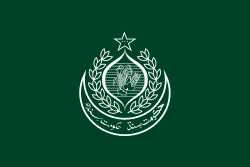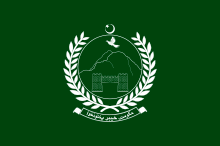Jamaat-ul-Ahrar
| Jamat-ul-Ahrar | |
|---|---|
|
Participant in the War in North-West Pakistan and the Global War on Terrorism | |
| Active | August 2014– present[1] |
| Leaders | Omar Khalid Khorasani |
| Headquarters | Nangarhar Province, Afghanistan |
| Area of operations |
Federally Administered Tribal Areas (FATA) Khyber Pakhtunkhwa Afghanistan |
| Originated as | Tehrik-i-Taliban Pakistan faction (Split away in August 2014) |
| Allies | Islamic State of Iraq and the Levant – Khorasan Province |
| Opponents |
|
| Battles and wars | |
Jamaat-ul-Ahrar ("Assembly of the Free," abbreviated as JuA[2]) is a terrorist organization that split away from Tehrik-i-Taliban Pakistan in August 2014.[3] The group came to prominence after it claimed responsibility for the 2014 Wagah border suicide attack. In October 2017, there were unconfirmed reports that Omar Khalid, the leader of the JuA, had died from injuries sustained in a US drone strike in Paktia Province, Afghanistan.
History
Roots and development
In September 2014, Tehrik-i-Taliban Pakistan chief Fazlullah ousted Mohmand Agency chief Omar Khalid Khorasani (former leader of Ahrar-ul-Hind). Omar Khalid Khorasani and his associates in Mohmand Agency had accused the TTP leadership of deviating from the TTP ideology, leading to the formation of splinter group TTP Jamaat-ul-Ahrar.
The Tehrik-i-Taliban Pakistan was effectively divided into two factions. The original TTP is headed by Fazlullah, who was elected in November 2013 following the killing of ex-chief Hakimullah Mehsud in a U.S. drone strike. In February 2014, Ahrar-ul-Hind, headed by Umar Qasmi (former leader in the Lashkar-e-Jhangvi) was formed after TTP opened peace talks with the Pakistani government. It later merged into Jamaat-ul-Ahrar, a second splinter group that broke away from Tehreek-i-Taliban in Pakistan on 4 September 2014, and named Omar Khalid Khorasani as its commander.[4]
Relations with TTP
The group had announced they would no longer recognize or obey Mullah Fazlullah as their Emir.[5] In March 2015, the group's spokesman announced that it swore loyalty to main TTP leadership again.
Designation as Terrorist organization by United Nations
On 6 July 2017, the Security Council’s 1267 Sanctions Committee approved the addition of Jamaat-ul-Ahrar in the list of entities and individuals subject to the assets freeze, travel ban and arms embargo. Pakistan had proposed this listing.
Organizational structure
Leaders
- Omar Khalid Khorasani (aka Abdul Wali)- previously led a faction called Ahrar-ul-Hind. He is also one of the founding members of the TTP and is a former journalist from Mohmand agency.[5] It was reported that a JuA spokesman Asad Mansoor had told AFP news agency that Khorasani on 18 October 2017 had succumbed to his injuries received in a United States drone strike in Paktia Province of Afghanistan.[6] Pajhwok Afghan News however stated that a source close to the group had denied his death.[7] Long War Journal reported that a statement on Telegram issued under Khorasani's name denied his death, while confirming the death of Khalifa Umar Mansour. The outlet noted that the spokesman operating the group’s Telegram account did not announce his death.[8] His death also was not confirmed by United States.[7][8] Reports of Khorasani's death were proven false when the United States added Khorasani to the U.S State Department's Rewards for Justice wanted list on March 7, 2018.[9]
Spokesmen
- Asad Mansoor
Former
- Ehsanullah Ehsan, he surrendered himself to Pakistan's Security Forces in April 2017.[10]
Operation Khyber-1
On 9 November, at least 13 militants were killed in security forces' offensive in Akakhel which included among the dead two suicide bombers and a key commander. Ehsan confirmed that their key commander Abu Jandal was killed during the 9 November bombing in Khyber Agency's Tirah Valley.[11]
Claimed and alleged attacks









Split
JuA was split into two groups, with a video statement on 12 November 2017 announcing that the Hizbul Ahrar group, formed in Nangarhar province of Afghanistan on 11 November, will be headed by militant commander Mukarram Khan. Khan had previously served as an important commander and spokesman of JuA. The statement said that Khan left JuA because of differences with its chief over "attacks against minority Christians, killing civilians, extortion, kidnapping for ransom and other acts he deemed un-Islamic".[26]
See also
References
- ↑ "Pakistani splinter group rejoins Taliban amid fears of isolation". Reuters. 12 March 2015. Retrieved 13 March 2015.
- ↑ "U.S. drone strike kills militant whose group killed 250 in Pakistan". Reuters. 19 October 2017.
- ↑ "Pakistan Taliban faction announce split, new leader". Agence France-Presse. 4 September 2014. Archived from the original on 11 November 2014. Retrieved 11 November 2014.
- ↑ "Taliban splinter group Jamaat-ul-Ahrar forms in northwestern Pakistan". Pakistannewsviews.com. Archived from the original on 4 November 2014. Retrieved 20 May 2015.
- 1 2 "TTP Chief Mullah Fazlullah ousts Commander Umar Khorasani". Retrieved 19 May 2015.
- ↑ "Pakistan militant leader 'killed by drone' in Afghanistan". BBC.
- 1 2 "Jamaatul Ahrar denies Khurasani's death in drone strike". Pajhwok Afghan News.
- 1 2 "Leader of Jamaat-ul-Ahrar emerges after reports of his death". Long War Journal.
- ↑ https://rewardsforjustice.net/english/abdul_wali.html
- ↑ http://www.aljazeera.com/news/2017/04/pakistani-taliban-leader-ehsanullah-ehsan-surrenders-170417131146226.html
- ↑ Zahir Shah Sherazi. "Jamaatul Ahrar confirms death of commander in Khyber airstrikes". Retrieved 19 May 2015.
- ↑ "TTP splinter groups claim Wagah attack; 60 dead". Retrieved 19 May 2015.
- ↑ Zahir Shah Sherazi. "Twin blasts kill at least six people in Mohmand". Retrieved 19 May 2015.
- ↑ three members of the Sindh Assembly and 50 workers were injured in the grenade attack
- ↑ "Jamaatul Ahrar claims responsibility for attack on MQM camp - PAKISTAN - geo.tv". 21 November 2014. Retrieved 19 May 2015.
- ↑ "Deadly blasts hit Pakistan churches in Lahore". BBC. 15 March 2015. Retrieved 15 March 2015.
- ↑ "A police official says a suicide bomber has attacked the entrance to a court in a northwestern Pakistan, killing 11 people". US News & World Report. 2016-03-07. Retrieved 2016-03-29.
- ↑ "69 killed as suicide blast rocks Lahore". www.thenews.com.pk. Retrieved 2016-03-28.
- 1 2 Burke, Jason (2016-03-28). "Lahore bombing is faction's boldest bid to stake claim as Pakistan's most violent terrorists". The Guardian. ISSN 0261-3077. Retrieved 2016-03-28.
- ↑ "Lahore bombing: Pakistan mourns as death toll rises". www.aljazeera.com. Retrieved 2016-03-28.
- ↑ "At least 28 killed in suicide blast at Mohmand Agency".
- ↑ Dogar, Arshad. "13 martyred in Lahore suicide attack". The News International. Retrieved 14 February 2017.
- ↑ "Motorcycle suicide bomber hits protest group in Lahore, Pakistan". CBS News. Retrieved 14 February 2017.
- ↑ "Jamaat-ul-Ahrar gives details of its targets in a video". Pakistan Today. Retrieved 14 February 2017.
- ↑ "22 killed in explosion outside imambargah in Parachinar market". Dawn. 2 April 2017. Retrieved 31 March 2017.
- ↑ "22 Pakistani Taliban splinter group splits further over tactics". Associated Press. ABC News. 12 November 2017. Retrieved 12 November 2017.